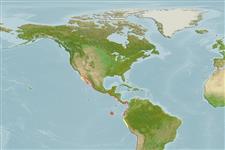>
Eupercaria/misc (Various families in series Eupercaria) >
Lutjanidae (Snappers) > Lutjaninae
Etymology: Lutjanus: Malay, ikan lutjan, name of a fish.
More on author: Gill.
Environment: milieu / climate zone / depth range / distribution range
Ecología
marino; salobre asociado a arrecife; rango de profundidad 0 - 60 m (Ref. 9313), usually 5 - 12 m (Ref. 5227). Tropical; 36°N - 17°S, 121°W - 75°W (Ref. 55)
Eastern Pacific: northern Mexico to northern Peru.
Tamaño / Peso / Age
Maturity: Lm ? range ? - ? cm
Max length : 170 cm TL macho / no sexado; (Ref. 9313); peso máximo publicado: 35.7 kg (Ref. 4699)
Espinas dorsales (total): 10; Radios blandos dorsales (total): 13-14; Espinas anales 3; Radios blandos anales: 8. Snout rounded, preopercular notch and knob moderate or weak. Scale rows on back rising obliquely above lateral line, rows occasionally horizontal in juveniles. Scale rows on cheek 5 or 6. Back and side dark olive brown to copper-red, becoming whitish ventrally. Young with 9 dark cross-bars; margin of spinous dorsal and most of anal fin black.
Adults inhabit coastal rocky and coral reefs up to at least 60 m depth (Ref. 9313). Juveniles may be encountered in estuaries with mangroves and mouths of rivers (Ref. 9313). Carnivorous, feed on big invertebrates (such as crabs, prawns and shrimps) and fish (Ref. 9313). Marketed fresh or frozen (Ref. 9313).
Life cycle and mating behavior
Madurez | Reproducción | Puesta | Huevos | Fecundidad | Larva
Allen, G.R., 1985. FAO Species Catalogue. Vol. 6. Snappers of the world. An annotated and illustrated catalogue of lutjanid species known to date. FAO Fish. Synop. 125(6):208 p. Rome: FAO. (Ref. 55)
IUCN Red List Status (Ref. 130435)
Threat to humans
Harmless
Human uses
Pesquerías: comercial; pesca deportiva: si
Más información
ReferenciasAcuiculturaPerfil de acuiculturaRazasGenéticaElectrophoresesheritabilidadEnfermedadesProcesamientoNutrientsMass conversion
ColaboradoresImágenesStamps, Coins Misc.SonidosCiguateraVelocidadTipo de nataciónSuperficie branquialOtolitosCerebrosVisión
Herramientas
Special reports
Download XML
Fuentes de Internet
Estimates based on models
Preferred temperature (Ref.
123201): 22.4 - 29.1, mean 26.7 °C (based on 228 cells).
Phylogenetic diversity index (Ref.
82804): PD
50 = 0.5000 [Uniqueness, from 0.5 = low to 2.0 = high].
Bayesian length-weight: a=0.01514 (0.01324 - 0.01730), b=2.97 (2.94 - 3.00), in cm total length, based on LWR estimates for this species (Ref.
93245).
Nivel trófico (Ref.
69278): 4.1 ±0.72 se; based on food items.
Resiliencia (Ref.
120179): Muy bajo, población duplicada en un tiempo mínimo superior a 14 años (Preliminary K or Fecundity.).
Fishing Vulnerability (Ref.
59153): Very high vulnerability (90 of 100).
Nutrients (Ref.
124155): Calcium = 14.9 [8.1, 24.1] mg/100g; Iron = 0.265 [0.161, 0.448] mg/100g; Protein = 18.8 [17.2, 20.2] %; Omega3 = 0.11 [0.07, 0.17] g/100g; Selenium = 75.5 [40.6, 134.0] μg/100g; VitaminA = 122 [21, 521] μg/100g; Zinc = 0.367 [0.272, 0.518] mg/100g (wet weight);
